Top 6 best ways to tie tomatoes in a greenhouse: step-by-step instructions and advice from experienced gardeners
The use of tall tomato varieties for growing is considered the most expedient from an economic point of view. Tall bushes of plants allow you to get a rich harvest from a small area. Such varieties require obligatory gartering to supports in order to keep the fruits and plants unharmed.
There are many ways to tie up tomato bushes. It is worth familiarizing yourself with the simplest and most effective of them before cultivating this crop.
Why are tomatoes tied up?
Tying up tomato bushes is carried out in order to prevent the stem from breaking due to the heavy fruits that form on the plant. If you do not tie it up, then after the fruits form and grow, the stem will bend and, if it does not break, it will begin to creep along the ground. In such a situation, plants are easily damaged by slugs and other ground-based pests, as well as fungal diseases.

Benefits of proper garter
The following are the benefits that a gardener receives from tying up bushes:
- easier to care for plants;
- at watering there is no risk of water getting on the surface of the leaves, which prevents rotting of the bushes;
- it is much more convenient to form and carry out pinching on tied bushes;
- upright bushes receive more light, which helps the fruits ripen faster;
- free access of air reduces the risk of fungal diseases, in particular late blight.
When to tie up tomatoes
The first garter for tall varieties is done 3-5 days after planting the seedlings. In the future, this event is carried out regularly as the bushes grow. Although some gardeners recommend that the first tying be carried out only after the seedlings have taken root well and form 2-3 new leaves in a permanent place of growth.
What to do before gartering
Before starting to garter the bushes, the tomatoes are pinched. This event increases crop productivity. If you do not remove the side shoots that form in the axils of the leaves, then you may not wait for fruiting, since the plant will begin to form only stems with flowers.
Reference. Stepsoning carried out once every 10-12 days, preventing the stepsons from growing by more than 5 cm.
Decide in advance on the method of tying the bushes, prepare all the materials necessary for this. If fabric, elastic bands or other garter devices are used for a second season, they must first be washed and disinfected.
Devices and materials for garters
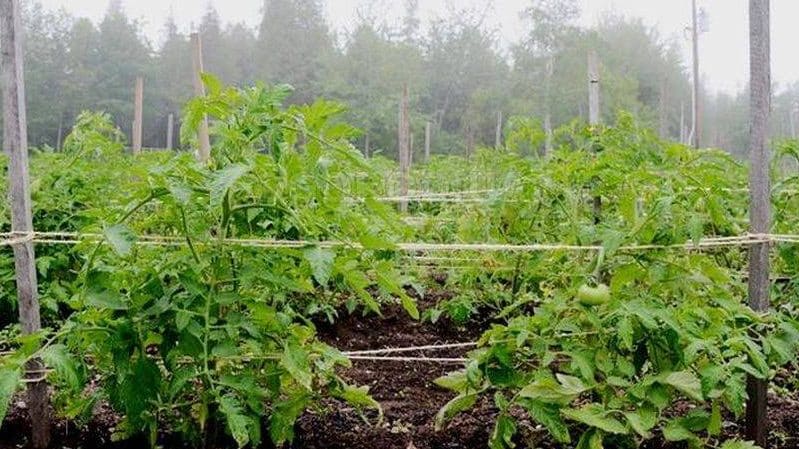
To securely fix the plants, supports and garter material are used. Long wooden stakes or metal rods are used as supports. As for the material for tying, soft fabric or elastic but durable material is suitable.
There is a special device for gartering, which in appearance resembles a combination of garden pruning shears and a stapler, which is equipped with adhesive tape and a cutter. Using such a device, it is much easier to fix the branches of a tomato bush to a support. The plant is not injured in this case.
A simple and inexpensive option - plastic clips that fasten with one click. The devices are reliable and can withstand any weight. They can be used for many years in a row. For fixing plants, you can select clips of a suitable size for stems and branches with fruits.
Reference. You cannot use thin thread, fishing line or other hard materials to secure the stems of a plant, as they can injure the stem or even break it.
Effective ways to tie tomatoes
When choosing a method for tying bushes, focus on the characteristics of a particular variety, the weight of the fruit, and the height of the bush. It is necessary to decide on the scheme and type of attachment of plants to the support even before planting the seedlings.
The easiest way to tie tomatoes is with stakes.
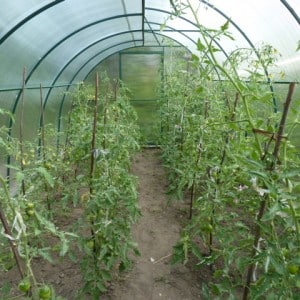
Simple stakes are used as support, which are installed near the plants. The height of the support approximately corresponds to the height of an adult plant.
This method is suitable for tomato varieties with medium-sized fruits and for bushes of medium height. Tall or heavy plants may fall along with the installed support to which they are tied.
Wire hook method
One of the most ancient methods. The author of this technology is I. Maslov. To create structures, you will need a strong thread or fishing line, on which small loops are made at intervals of 15-20 cm. This fishing line is attached to the ceiling of the greenhouse near each bush.
Using wire hooks or open paper clips and rubber bands, attach the tomato stems to the looped fishing line. They grab it with an elastic band under the branch of the bush and hook it to the nearest loop.
The convenience of this method is that as the plant grows, it is enough to simply add new hooks and secure the stem. This design is capable of holding even the heaviest bunches. Due to the elasticity of the elastic band, they will lean slightly toward the ground, but will not fall or break.
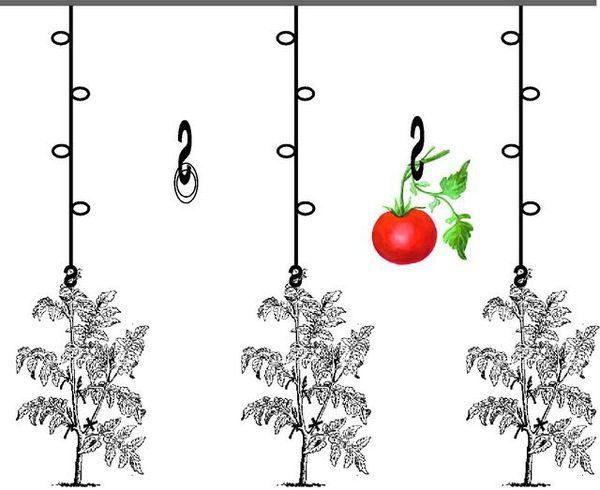
Horizontal garter method
Horizontal fastening (on a trellis) is used for tall plant varieties. Install strong metal posts along the edges of the greenhouse, after which the rope is pulled, maintaining an interval of 30 cm. The structure should look like a strong mesh.
Plastic clips are used to attach to the trellis or all plants are threaded through a rope mesh. You can replace the rope structure with ready-made trellises made of wooden or plastic material (slats).
Reference. When constructing a trellis, it is important to take care of its reliability so that it does not fall under the weight of the fruit.

Using a Grid
A metal or plastic mesh is used as a support, which is attached between the posts of the greenhouse frame. The most convenient to use is considered to be a coarse mesh. On it you can place the stems and branches of plant bushes in accordance with the direction of their growth.
As the plant develops, you can change the place of tying and secure it at a different, more convenient level.
Arranging a trellis - for tall varieties of tomatoes
Another type of trellis is vertical, in which plants are tied to the roof of the greenhouse. To do this, use a rope, one end of which is fixed to the ceiling of the greenhouse, and the other to the stem of a tall tomato bush. Using this method, you can tie up even the heaviest bunches of plants without fear that the support will break or fall.
Reference. To prevent injury to the branches and stems of bushes, the support rope should be chosen wide, soft and durable.
The use of bush holders when growing tomatoes

The use of bush holders, or in other words, a wire frame, is suitable for varieties that form compact bushes with a large number of fruits. The design uses a mesh with large cells, which is wrapped around the plants in the shape of a cylinder and dug into the ground.
With the help of a bush holder you can secure both the main stem and heavy branches with large fruits. At any time, the device can be dug up and moved to another area. The only disadvantage of this tying method is the difficulty of harvesting.
Special recommendations for tying tomatoes in a polycarbonate greenhouse
What is the best way to tie tomatoes in a polycarbonate greenhouse?
Despite the fact that the trellis fastening method is considered the most labor-intensive and complex, it is recommended to use it in polycarbonate greenhouses. Polycarbonate is characterized by good light transmission and quickly accumulates heat.
The maximum amount of light is provided to the plants and “heat stroke” is prevented by allowing the branches to be arranged evenly and spaciously on the trellis.
Are the methods of gartering different in open ground?
If low-growing varieties are grown in open ground, then in many cases there is no need to tie up the plants. However, if the bushes produce a large number of fruits that are heavy in weight, then the stems and branches of the plant will still have to be fixed.
To do this, choose any of the above methods of tying in a greenhouse. But not all of them are convenient to use in open ground conditions.The trellis method, both horizontal and vertical, will be very problematic to apply in a garden bed.
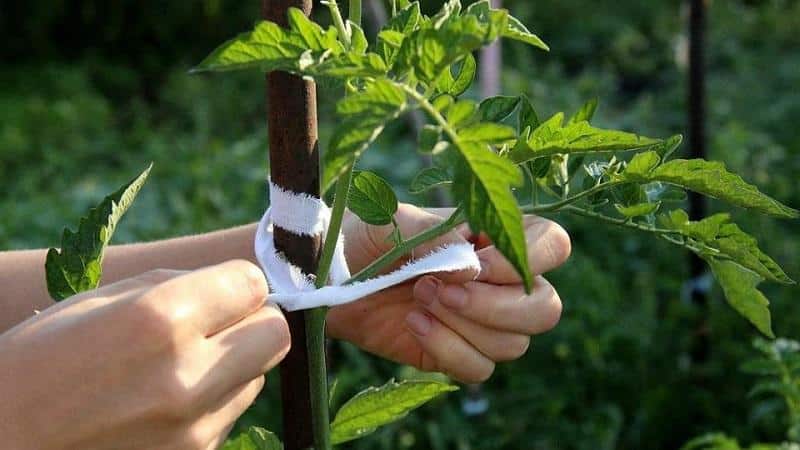 Gardeners use the simplest method with stakes or construct bush holders. Tying tomatoes in open ground, choose a reliable structure, since strong winds can knock down the support and the plant. When constructing a cylinder of mesh with large cells around each tomato bush, it is recommended to dig it a little deeper than in a greenhouse. This will give the structure reliability and stability.
Gardeners use the simplest method with stakes or construct bush holders. Tying tomatoes in open ground, choose a reliable structure, since strong winds can knock down the support and the plant. When constructing a cylinder of mesh with large cells around each tomato bush, it is recommended to dig it a little deeper than in a greenhouse. This will give the structure reliability and stability.
Despite the fact that constructing a wire frame for each plant is costly and time-consuming, and it will be more difficult to collect fruits from the bushes, it should be preferred if there are frequent, strong and gusty winds in the region where the crop is grown.
Secrets of experienced gardeners for gartering tomatoes
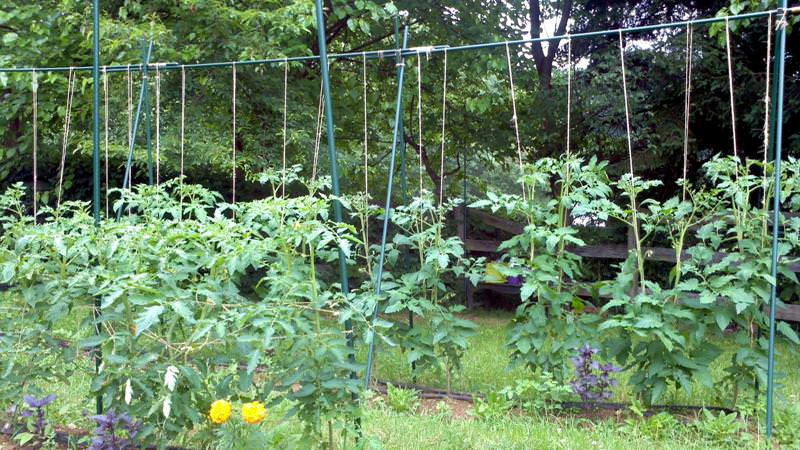
When starting to plant tomatoes, study the recommendations of experienced gardeners:
- you should not tie the stems to the supports using a figure eight knot, as this increases the risk of damaging the plants;
- tie up not only the main stem, but also individual branches with bunches of tomatoes - this will protect them from falling to the ground;
- use staking only when growing medium-sized crop varieties;
- tall tomatoes it is better to attach to a trellis;
- to prevent the appearance late blight and other fungal diseases, fruits should not be allowed to come into contact with each other or with the soil.
3 mistakes when gartering tomatoes in a greenhouse
Three main mistakes that gardeners make when staking plants:
- They choose a method for fixing plants to supports, without taking into account varietal characteristics. For example, tall crops are attached to free-standing stakes, which subsequently leads to loss of stability of the supports, breaking of branches or falling of fruits onto the ground.
- Irregular tying during the growing season. The tomato bush grows and develops constantly, which means it increases in size. It is not enough to tie it up at the initial stage of development after planting the seedlings in the ground. The event should be carried out regularly, focusing on the height of the bush. If you tie it once, then over time the plantings will begin to thicken and the plants will not be able to receive enough light and air. This will lead to inhibited fruit development and the appearance of fungal diseases.
- Incorrectly selected garter materials. Do not use natural fabrics, thin, hard threads or wire, since the former are susceptible to rotting, and the latter damage the stems and branches of the plant. If garter devices have been used for more than a year, then before you begin fixing plants to supports, you need to disinfect all garter material.
Reference. If fabric is used as a garter material, then before reuse it must be washed using laundry soap or boiled. You can also use a solution of potassium permanganate or other disinfectants that will eliminate possible residual infection remaining in the tissues.
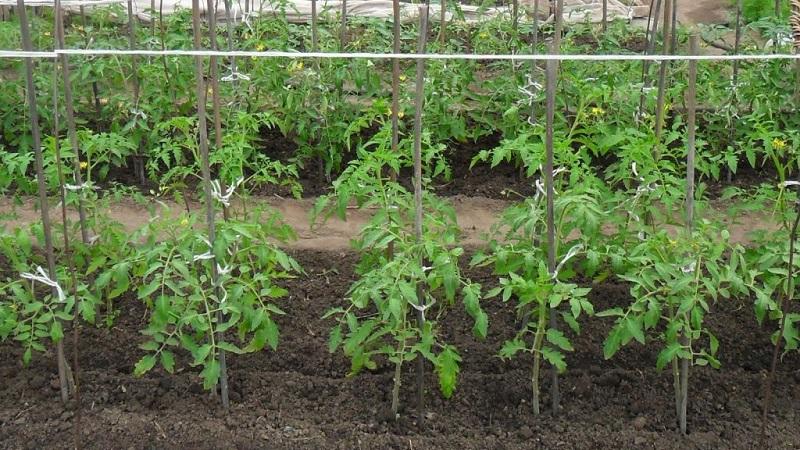
Reviews from gardeners
Let's find out what experienced gardeners say about tying.
Galina, 38 years old, Ufa: “I love tomatoes very much, I have been growing them for a long time and take photos for my website. As for the garter, it is better to prepare everything for this event literally immediately after planting the seedlings.I always use a trellis from which I attach twine to each bush.”
Snezhana, 45 years old, Perm: “If a tall variety of tomatoes is planted, then it needs to be tied up immediately. When planting, it does not matter whether it is an individual support or a rope that is tied to the roof of the greenhouse. The main thing is that the plants are fixed. I can’t do without stakes in my garden.”
Conclusion
Measures for tying tomatoes to supports not only provide ease of care for the crop, but also create the most comfortable conditions for its growth and development. You need to decide on the method of tying the bushes at the stage of planting seedlings in a greenhouse or open ground.
It is important to use a clean device and ensure the reliability of the supports that are used to secure the bushes.